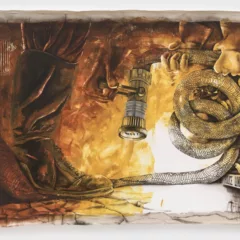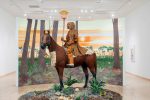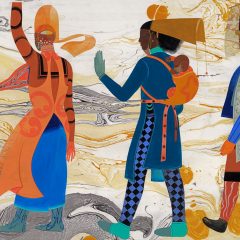Over the last year, the new Director of Temple Contemporary, Jova Lynne, has demonstrated her commitment to education, equity, and social engagement in the group show With or Without You: America and the solo exhibition Beyond the Words of Earth, featuring Rajni Perera’s exquisite works.
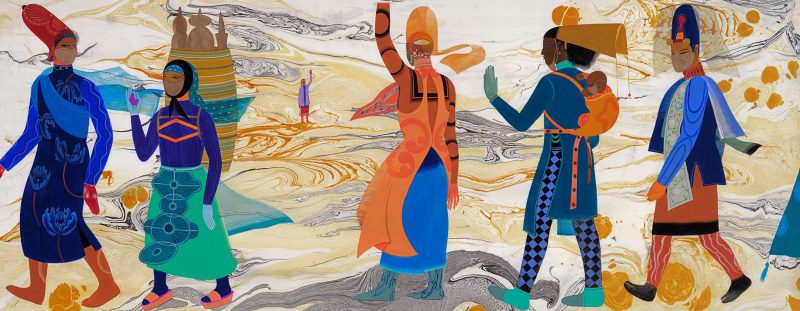
on hand-marbled kozo paper, mounted on muslin. 35.4″ x 91.5.” National Gallery of Canada. Photo
courtesy of artist.
Both exhibits took on pressing issues facing our communities within the wider global context and are evidence of Lynne’s drive to bring complex and well conceived exhibitions to the Temple campus. In talking to her it is clear she has plans to develop more community connections and integration within the neighborhoods surrounding Temple in the second year of her tenure. Notably, Lynne is a working artist, whose video Paradise Ad #1 (2019), is featured in the 20/92 Video Festival at the Icebox Project Space (up to Mar. 9). In January, Jova Lynne sat down with me at Temple Contemporary to discuss her first year as Director.
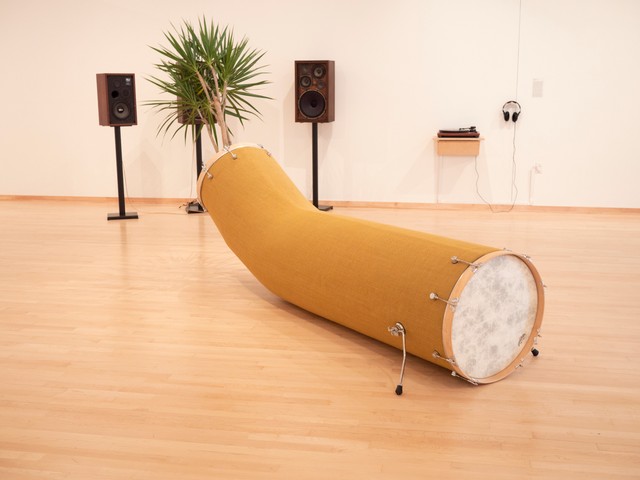
Julia Marsh: Tell me about your career path, what led you here?
Jova Lynne: I grew up in New York City and being in New York I went to art school most of my life. I was enrolled in after school programs at art institutions like Cooper Union and the Smithsonian. When I went to college I was thinking “I’m going to be an art teacher, that’s what I am going to do.” Then I went to college and I discovered video and all these other different ways of making that I really hadn’t thought about. After college, I became a program director for a center that uses media to teach people about world problems, like social justice, and while I was doing that I was also doing museum education. And that’s how I ended up working as an arts administrator, in general, and in museum education and art education programs.
I have an MFA in photography and while I’m still working on my practice, my job has developed into curation, and that part of me that always wanted to be an educator is very much fed through curation. I feel it’s not your standard teaching position, but it is. All of this comes together through interpretive strategies that I think about when I am curating. So, before this position at Tyler, I was the senior curator at the Museum of Contemporary Art Detroit, which is where I really grew and flexed and figured out how to articulate my curatorial practice. Then I became interested in what it would be like to work in a more formal educational setting, like Tyler. So, it all sort of came together. In my role here my official title is Director of Public Programs and Exhibitions, and so in addition to curating Temple Contemporary, I’m also thinking about what are our interpretive strategies; how do we help foster that next generation of artists through exhibitions and public programs.
JM: Please describe your exhibition program.
JL: You know, I think the role of contemporary art is to be responsive to the now and so a lot of my curatorial interest lies in working with artists, who are asking questions that relate to the now. All of this is obviously rooted in art history and general history, but who are the artists that really lean into interpreting the world as we know it? In Rajni Perera’s exhibition Beyond the Words of Earth , it was all about the future; With or Without you America was more about the past and present, and so with all the artists I work with I’m really centered on supporting emerging artists. I think the word emerging is so big, and what does it mean to be an emerging artist? I still am trying to figure out what it takes to go from emerging to mid-career to being established. There’s a trajectory there. So how do we foster or better support emerging artists, get flowers sooner, I guess is the best way to say it. I’ve never worked at a collecting institution, and while I think collections are super important, I am more interested in the here and the now.
JM: In the press release announcing your hire, you said you are interested in raising awareness of the craft of emerging artists.
JL: It goes back to what I said earlier, I think something that curators are really grappling with, and as an artist you know, I am concerned with what it means to emerge? How has the field been disproportionately represented in the art world? There was a study that came out recently in ARTNews that showed hands-on metrics for race, gender and sexuality; what’s represented in most collections by who’s being collected; who’s being exhibited, etcetera. The disparities were really, really intense.
So, what I’m trying to do with the access and privilege that I have in the field is just level the playing field, a little bit; try really to show artists who are working in the margins who maybe haven’t been represented as much as they should. And that encompasses all races, all genders, and all class backgrounds. When 2020 hit, there was a sense we needed to really think about the art world and how the art world can do better to represent marginalized communities and groups. I feel like since then there was like a big uptick in these actions, and now we’re starting to go back to the status quo. I want to be a part of expanding the field.
How does the art world actually become a more equitable place, and when we say equity what do we actually mean. I will say that I think Dean Susan Cahan is trying to do a lot, so that Tyler, at the very least, reflects the real world art world and what needs to happen across the board. I think students here are getting an education and Temple Contemporary’s role in that is still in development, but with my first two shows it’s been really amazing to see people interact with the art.
JM: How do you think contemporary art is important to higher education and are you trying to engage the larger campus community? And how is that going?
JL: Well, you know January 31st marked my first year here, and I’m still getting to know Philadelphia. I’m still getting to know the campus. When I got here, thanks to a grant from the William Penn Foundation and with the help of Dean Cahan and Kate Ware, I had the opportunity to administer a grant which invited 35 community members from Philadelphia, but also a couple people nationally, to come together and talk about “What is the function of a university gallery?”; “Who do we need to serve?”; “How do we take care of our constituents?”; which is a very wide and vast array of people. Something that became really apparent to me that’s key to who I am as a curator is how do we take care of our neighbors and build coalition with our neighbors, while still maintaining the integrity of who we are? As a result of these conversations, one of the first things I did was host a series of community risograph weeks, a technology which apparently everybody knows we have. I had no idea. So, folks were able to come in, get trained and do printing for free. So that’s a tiny thing, right? This came out of a reflection of students wanting access to this, community members want access to this, everybody wants that. One of the bigger goals, that’s going to take a little bit more time for me to get to, is having a really great balance between exhibiting international artists like Rajni Perera and local artists, like many who participated in With You or Without You America. I want to give people that opportunity.
I have to thank the faculty here, who’ve been really great about bringing their students in to see the shows, doing talks. Coming from a museum background, academia is really different. The goals are different, the priorities are different. And, so I’m really grateful to the team here for being with me, while I try out this weird experiment, where we’re going to show formal exhibitions and we’re going to be a community space. We’re going to figure out how to be a little of both while also recognizing our limitations.
We got a grant from the Pew to mount a show that’s going to open in the summer of 2024. This show will feature Tiona Nekkia McClodden, Pat Phillips and Karen Olivier. It’s going to be one of our bigger endeavors. The exhibition will be anchored here, but will also take place off site. Part of why I wanted to do that is that art can be for everybody, and people might not feel comfortable coming into the ivory tower. So we asked ourselves how we can still be great stewards of what we do, and maybe by doing something off site we can help facilitate that process. When schools don’t prioritize art programming, I think some people don’t step foot into the gallery or museum until they’re in their 20s, sometimes even 30s. So I hope that at Temple Contemporary we can also be representative off site so that people know art is possible anywhere.
JM: I’m curious what you think makes Temple Contemporary unique in Philadelphia, not only because it’s an academic gallery, but what about it makes it unique among other entities?
JL: To be frank our location is very specific. Being in north Philadelphia, I think it’s something that’s very special, which is why I want to hone in on thinking about how we can better engage with our neighbors. There’s a lot of amazing other artist-run spaces, including those in the Crane Building, as well as The Clay Studio. One of my goals is to be more integrated into what’s going on there in these galleries with their proximity to us. There’s such rich talent in this area.
JM: Would you go as far as having opening nights the same nights?
JL: Yeah. Part of the challenge is that we’re on an academic calendar, which is slightly different. We’re figuring it out. But, I’d also like to say something that makes us unique is our ability to take risks because we have the institution behind us, and so we can take risks in a different way.
For instance, in Rajni’s show, some of this work was on loan, some of it brand new. She came and worked with students and faculty from the painting department to make the mural and the glass department to make the scepter. What we offer artists, in terms of the institutional resources, is really, really important.
You know, when I think about how the art world functions and having exhibitions as a pathway to legitimize one’s career, I think about the importance of With You or Without You America. Some of those artists have had more opportunities to exhibit, some had less. I remember the first time I was in a show with somebody whose work I was like “Oh my God!” I’m in a show with them. That’s profound, and that is artist impact. I think that artist impact vibrates. Being able to do an exhibition like this that people see and are wowed by is really amazing.
Because museums have a different approach than most formal galleries do, it’s also been interesting being a former museum curator and now working at an academic gallery, but still being very adamant about best practices for engagement. We’ll see how that goes here. Also, Dean Cahan’s background is also in museum education, so it’s been really important having her support in this.
Another example of our expansive programming, is the walking tours of heat zones in North Philadelphia being arranged by our graduate student Allison [last name], who is really interested in and invested in climate change and what’s happening on the ground in Philadelphia. She is invested in thinking about how art and mapping coalesce. This is an example of something we can do because we’re a part of the school, and we’re also a gallery.
JM: What do you need to achieve your goals here? Is there something you need that you want to tell the universe?
JL: I just want people to come and hang out. That’s really what I want. I’m really grateful we’re having this conversation because I really hope that more people come here and learn about what we’re doing and what our programs are and the amazing people that we’re bringing in will result in a more engaged audience. I’d like to think that we’ll have more good times.
JM: What are you reading these days?
JL: What am I reading these days? I’m reading The Body Keeps the Score. I’m not that far in, but I’m a little mind blown. I’m also reading this young adult book, called the Firekeeper’s Daughter by Angeline Boulley. It’s about an Indigenous tribe in northern Michigan. I really like reading novels as a way to articulate my knowledge and understanding of Indigenous sovereignty.
JM: So, after Rajni’s exhibit what’s coming in next?
JL: So next we have the MFA shows, so we’re on a little bit of a pause. That starts on March 13th, right after Rajni’s show comes down on March 3rd.
JM: Do you have something coming in the summertime?
JL: In the summertime we become more of a community lab, where people can propose things to us and that we can hold space for them here. Part of why I don’t do formal exhibitions in the summer is because foot traffic is low; and until we really get ourselves a little more visible – and we will be careful with this timeframe, because it’s not awesome to have really good shows that nobody comes to see. So the next big opening will coincide with the start of the school year, which is going to be at the end of August.


